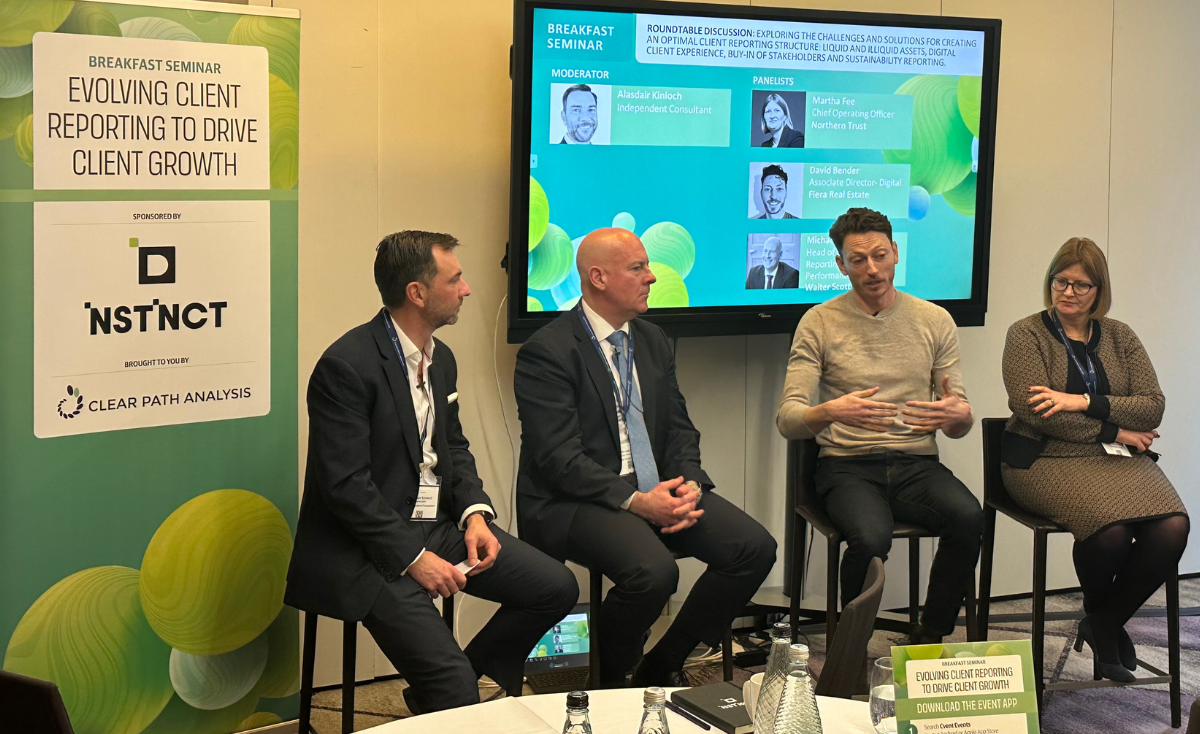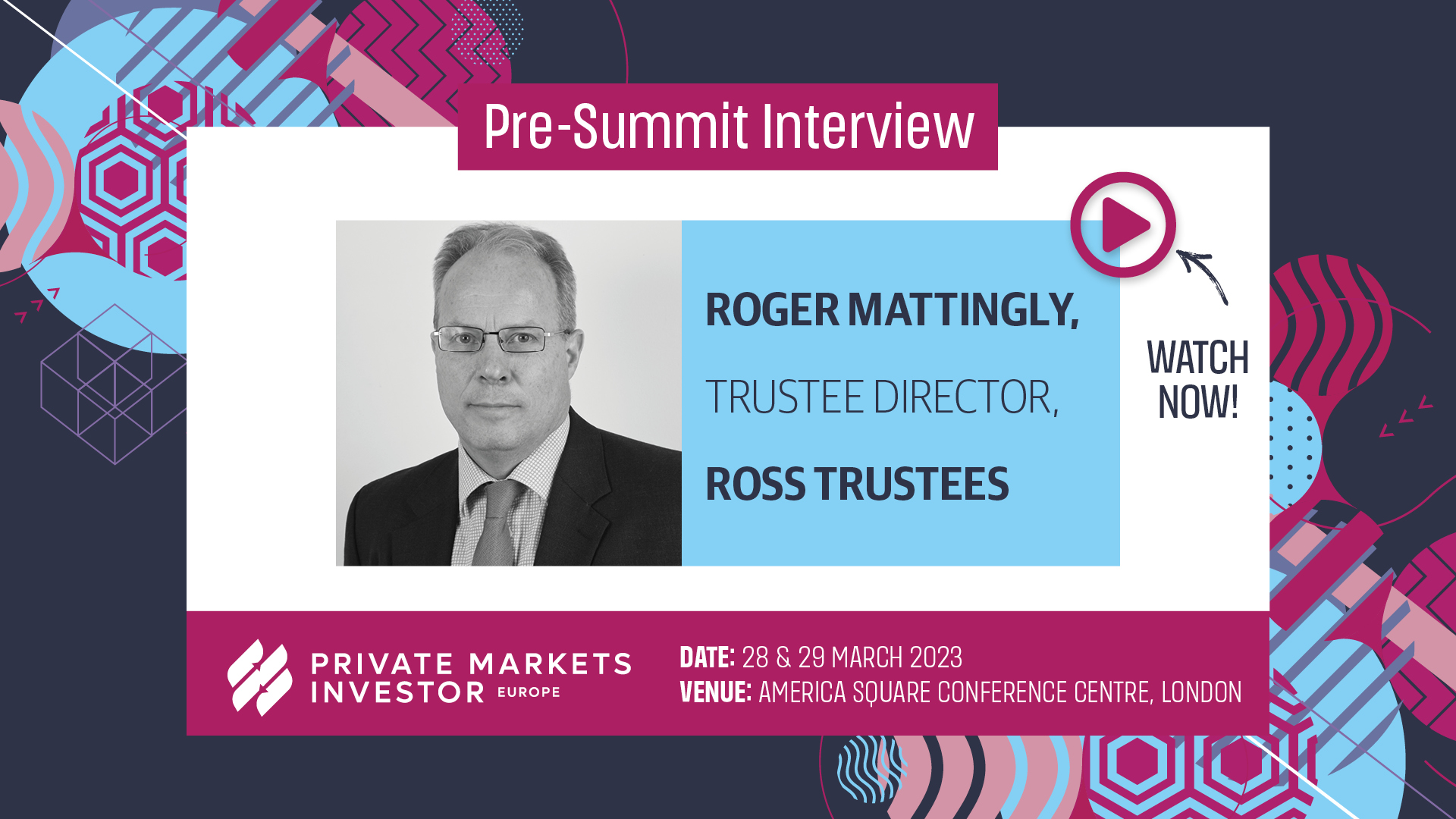 Alasdair Kinloch, Michael Clarke, David Bender, and Martha Fee (from left to right) discuss client reporting trends for 2023.
Alasdair Kinloch, Michael Clarke, David Bender, and Martha Fee (from left to right) discuss client reporting trends for 2023.
A lively panel debate on how client reporting can be developed and utilised to drive growth saw senior leaders – including Chief Operating Officers and Client Reporting Heads – cautioning that the industry should not underestimate the importance that asset managers are placing on the client experience.
The panel, which took place in London this past week, explored the challenges and solutions around creating an optimal client reporting structure, covering topics such as liquid and illiquid assets, the digital client experience, sustainability reporting, and stakeholder buy-in. It featured Martha Fee, Chief Operating Officer (COO) at Northern Trust, Michael Clarke, Head of Client Reporting and Performance at Walter Scott & Partners, and David Bender, Associate Director of Digital at Fiera Real Estate UK.
The ongoing boom in – and necessity of – digital operations was a particularly prescient topic. “Finance in particular has been a challenge largely due to the complexity of the data,” said Bender. Moving forward, it will be critical to an organisation’s longevity and success that it reaches a steady stage of digital operations, he added.
Client demand for digitalisation
Clarke said that his firm had automated the majority of their data systems and processes a few years earlier and then moved to spending 80% of their time on output. They were now focussed on the issue of ensuring that the data clients ask for is available. “We’re seeing a demand from clients in areas like due diligence and sustainability. But the tricky bit is that these things cannot always be automated.”
“It’s imperative we organise our data now and get upstream of it so we can be ready for this [client] demand when it does hit.”
Bender took a different stance, noting that his organisation hadn’t yet seen a huge amount of client demand. However, this trend was all the more concerning because it was indicative of a larger difficulty: that client demand doesn’t typically develop at a steady, visible pace. “Our clients might not yet have the comfort on their side or the ability to be self-served in ways we are prepared to serve them,” he said. “But these client-based abilities will ramp up and, when they do, they will do so very quickly.”
Bender’s solution to this inconsistent development was to plan in advance and anticipate well into the future. “It’s imperative we organise our data now and get upstream of it so we can be ready for this [client] demand when it does hit.”
Fee said that a complicating factor was keeping your client base in mind – because demand can vary depending on client makeup. “Our clients tend to be institutional asset owners,” she said. “We live in a platform-based economy now, so we need to be ready for this increasing hunger [for digital reporting] at a larger scale – even if it isn’t completely apparent at the moment.”
Because data demands are constantly changing, dynamism and agility must be developed across an organisation, said Alasdair Kinloch, the panel’s moderator and a private consultant. “Some clients log in [to a reporting portal] for your firm’s unique reporting capabilities, and you can see which ones do.”
Regulatory changes and ESG data
Fee was quick to point out that client demand wasn’t the only influencing factor; many digital reporting transformations were driven by regulatory changes.
“Reporting regimes in Europe [SFDR, SDR, TNFD] are the gift that keeps on giving.”
“Reporting regimes in Europe [SFDR, SDR, TNFD] are the gift that keeps on giving,” she said. Clients looking for compliance-based reporting – such as ESG data – were historically serviced by bespoke systems and products, but now, she added, it’s important to streamline. “We’ve seen the ESG phenomenon across the globe – the E in Europe and Asia, and the S in North America – and you need to embed this focus throughout the entire DNA of your organisation.”
Fee emphasised the significance of considering sustainability data points before the reporting process even begins, noting that managers cannot report on information they do not have. “If it’s not there in the investment process, it can’t be there in the reporting process,” she said. “This is key to consider when it comes to servicing client needs.”
When it comes to ESG data, volume of collection and frequency of delivery are pain points – alongside governance and stewardship, which can be sticky issues. “How do you govern [this data]? How do you take care of it going forward?” Clarke said, noting that questions such as these were important for fund operators and asset managers to have a handle on going forward.
Interoperability is the future
One key buzzword of discussion was ‘interoperability’, or the ability of digital systems to seamlessly exchange, share, and make use of information – specifically as relates to sustainability reporting. In October 2022, the International Finance Reporting Standards (IFRS) Foundation’s International Sustainability Standards Board (ISSB) released a paper that detailed the steps required to establish a global baseline for sustainability reporting, highlighting the “importance of achieving greater interoperability with jurisdictional requirements.”
In recent discussions, interoperability of systems and software has been seen as the foundational building block of client reporting – and the future of digital finance, more broadly. “The externalisation of this [interoperability] for clients is a product,” said Kinloch.
“There’s a convergence or an integration of layers that doesn’t exist yet but will emerge next.”
Understanding scale and position within a broader pipeline is key to the concept. “In commercial real estate, the big challenge is that people are used to owning their own silos, but need to be conditioned into understanding how they fit into the larger organisation,” Bender said. “There’s a convergence or an integration of layers that doesn’t exist yet but will emerge next.”
Fee said that this process was painstaking but inevitable. “It’s the modernisation journey of architecture. Now, we spend more time manipulating and consuming and repackaging data for clients. So we need to know how they want to use their information.”
Understanding the data
Bender was particularly outspoken on the topic of understanding data and its uses – from all angles of a business.
He said that the challenge was less about capturing the right data, and more about conceptualising the bigger picture: the who, what, where, when, and why. “Data itself isn’t the problem. We need to go upstream and ask: why are we collecting it? Who is involved in making it? What is the process it goes through?”
Bender added that because there are endless amounts of data and constant regulatory shifts, ESG can either be a hindrance or an opportunity for businesses. “We need to restructure organisations in ways that make the data a lot more understandable. [Our firm] built our data platforms completely internally – creating a network of data assets and mapping them internally to how our business operates.”
Getting comfortable with failure
Oftentimes, the culture of a company might need to shift in order to facilitate these mindsets; in fact, the panellists all agreed that there is typically failure involved. “People need to be comfortable with trying things that don’t always work out,” said Bender.
Fee said that getting comfortable with incubating ideas but pulling back if they aren’t working was critical to a company’s success. “I hate the word agile,” she said, “but it is about taking what works and applying it to ways of solving data needs. We’re now a lot more comfortable with pivoting and flexing in these areas.”
“The steps we’ve taken to simplify and modernise our data architecture have become our holy grail; it requires executive buy-in across all teams and silos.”
Understanding the culture of an organisation – especially how it handles failure – can also help with stakeholder buy-in. When it comes to galvanising senior management, Fee said that identifying strategic priorities is important, as is clear and consistent communication. “The steps we’ve taken to simplify and modernise our data architecture have become our holy grail; it requires executive buy-in across all teams and silos.”
Fee added that having – and properly articulating – the business case to support these efforts makes all the difference. “You need the ‘why’ to move the dial.”
This means slowing down, actively listening, and taking notes. “Dig into how [these tasks] fit into other teams, and let them tell you how things should work, because they are probably frustrated. Their initial reaction might be fine, but then when you slow down you find people are actually really frustrated [with current procedures],” said Bender.
“You really need to understand what people – clients included – are doing and why they are doing it.”
Please Sign In or Register to leave a Comment.
SUBSCRIBE
Get the recent popular stories straight into your inbox







